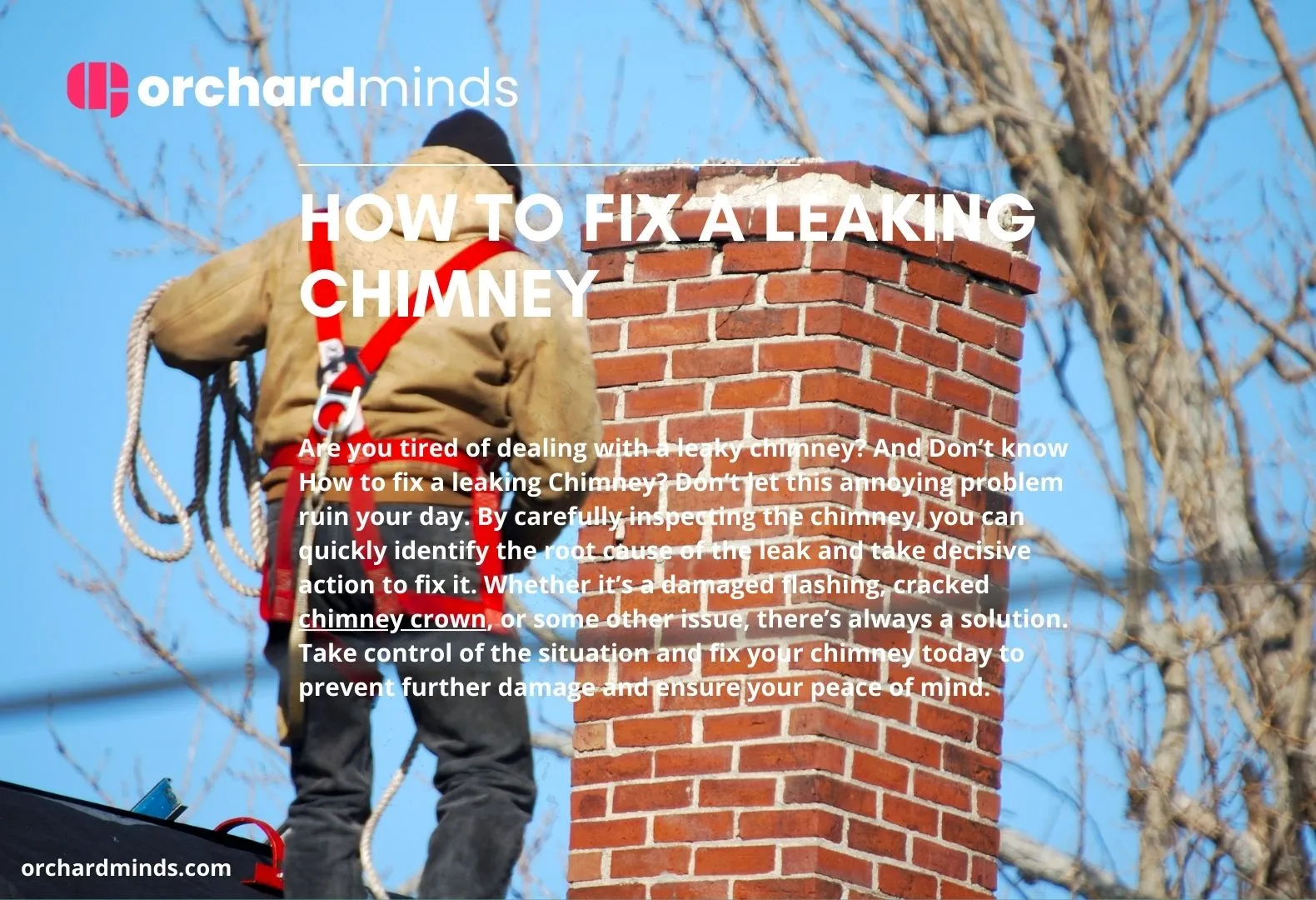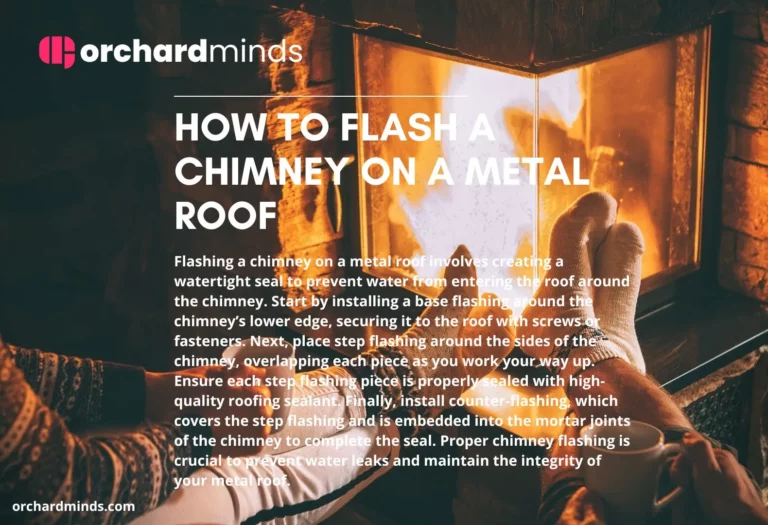Are you tired of dealing with a leaky chimney? And Don’t know How to fix a leaking Chimney? Don’t let this annoying problem ruin your day. By carefully inspecting the chimney, you can quickly identify the root cause of the leak and take decisive action to fix it. Whether it’s a damaged flashing, cracked chimney crown, or some other issue, there’s always a solution. Take control of the situation and fix your chimney today to prevent further damage and ensure your peace of mind.
How to fix a leaking chimney?
Fixing a leaking chimney involves identifying the source of the leak and addressing it appropriately. Start by inspecting the chimney for visible damage, such as cracked mortar, damaged flashing, or missing shingles. Repair any visible issues using high-quality roofing sealant or mortar. If the problem persists, consult a professional chimney technician to conduct a thorough inspection. Various factors can cause leaks, and a professional can identify and address the root cause, which may involve repairing flashing, resealing the chimney crown, or replacing deteriorated chimney components. Regular maintenance and prompt repairs are key to ensuring a dry and leak-free chimney.
How to Find and Repair Leaks Around Your Chimney
Finding and repairing leaks around your chimney is essential to prevent water damage and maintain the integrity of your home. To locate the source of a chimney leak, start by inspecting the interior for signs of water damage, such as discolored walls or ceilings. Then, examine the exterior for visible issues like cracked mortar, damaged flashing, or missing shingles. If the problem is not immediately evident, consider the following steps:
- Flashing Inspection: Check the chimney flashing, the metal strips that create a waterproof seal between the chimney and the roof. Look for loose or damaged flashing and reseal any gaps with roofing cement or replace damaged sections.
- Chimney Crown: Examine the chimney crown, the cement or concrete top of the chimney structure. Cracks or deterioration in the crown can allow water to enter. Repair any issues with a high-quality chimney crown sealant.
- Mortar Joints: Cracked or deteriorated mortar joints in the chimney can be a common source of leaks. Repoint or repair the mortar to restore the chimney’s watertight seal.
- Chimney Cap: Ensure that the chimney cap is intact and in good condition. A chimney cap acts as a barrier against rain, debris, and animals. Replace or repair any damaged caps.
- Sealing: Seal any gaps or cracks in the chimney structure using high-temperature mortar or sealant. Be thorough in addressing any potential points of entry for water.
- Roof Inspection: Sometimes, leaks around the chimney may not be directly related to the chimney itself but rather issues with the roof. Inspect the roofing material, especially in the vicinity of the chimney, for damaged shingles, holes, or gaps. Repair any roofing issues to prevent water infiltration.
If, after thorough inspection and repair attempts, the leak persists, it’s advisable to consult a professional chimney technician. They have the expertise and tools to identify and address complex chimney issues. Regular maintenance and proactive leak detection help ensure that your chimney remains watertight, preventing water damage and preserving the safety and longevity of your chimney and home.
Chimney Leaks Commonly Found in Attics
Chimney leaks in attics are a common issue that many homeowners encounter, and they can lead to extensive water damage and structural problems if not addressed promptly. Some of the most common causes of chimney leaks in attics include damaged or deteriorated flashing. The flashing is the metal or other material that seals the transition between the chimney and the roof. Over time, flashing can degrade due to weather exposure and temperature changes, creating gaps where water can enter. Cracks or gaps in the chimney crown, which is the cement or concrete top of the chimney structure, are another frequent source of leaks. Water can penetrate these openings and seep into the attic.
Additionally, damaged or deteriorated mortar joints in the chimney structure can allow water infiltration. To prevent chimney leaks in attics, it’s crucial to perform regular inspections, address any visible issues, and conduct proper maintenance to keep the chimney and flashing in good condition. If leaks persist or if you’re uncertain about the source of the problem, it’s advisable to consult a professional chimney technician who can identify and repair the issues effectively.
Is Your Fireplace Leaking?
Suppose you suspect that your fireplace is leaking. In that case, it’s essential to address the issue promptly to prevent water damage and maintain the safety of your home. Various factors, such as damaged flashing, deteriorated chimney components, or issues with the masonry, can cause leaks in or around your fireplace. Signs of a leaking fireplace can include:
- Water stains on the ceiling or walls.
- Musty odors.
- Visible damage to the chimney structure.
Regular inspections and maintenance, along with addressing visible problems, can help ensure your fireplace remains dry and functional. If you’re unsure about the source of the leak or need repairs, consult a professional chimney or fireplace technician to identify and resolve the issue effectively.
Water Leaks into Fireplace Ash Dump
Water leaks into the fireplace ash dump can be a concern as they can cause damage and lead to deterioration in the fireplace system. The ash dump is a crucial component designed to remove ashes and embers from the fireplace safely. When water infiltrates this area, it can mix with the ash and create a sludgy substance that may erode the fireplace structure over time.
To address this issue, it’s important to investigate the source of the leak, which can be due to issues with the chimney flashing, the chimney cap, or the chimney crown. Properly maintaining and sealing these components can help prevent water from entering the ash dump and ensure the continued functionality of your fireplace. Suppose you’re uncertain about the source of the leak. In that case, consulting a professional fireplace technician is advisable for an accurate diagnosis and effective repairs.
DIY Chimney Leak Repairs
DIY chimney leak repairs can be a cost-effective solution for minor issues. To address small leaks, you can use high-quality roofing sealant or cement to fill gaps and cracks in the flashing, chimney crown, or mortar joints. Replacing damaged or missing shingles near the chimney can also prevent leaks. However, it’s crucial to exercise caution and follow safety guidelines when working at heights, especially on the roof. For complex leaks or if you’re unsure about the source of the issue, consulting a professional chimney technician is advisable. They have the expertise to identify and address more significant problems and ensure the safety and integrity of your chimney and roof.
FAQs
- What are common signs of a leaking chimney? Common signs include water stains on the ceiling or walls, musty odors, damaged chimney components, and visible water entry points in or around the fireplace.
- Can I repair a leaking chimney on my own? For minor issues like small cracks, you can attempt DIY repairs using roofing sealant or cement. However, for complex or persistent leaks, consulting a professional chimney technician is advisable.
- How do I find the source of the chimney leak? Inspect the flashing, chimney crown, mortar joints, and chimney cap for visible damage. Water may be entering through these areas. If you can’t identify the source, consider professional inspection.
- Can a leaking chimney be fixed without professional help? Minor leaks can be fixed with DIY methods. However, more significant or persistent leaks often require the expertise of a chimney technician to ensure a proper and lasting repair.
- What are the most common causes of chimney leaks? The most common causes include damaged flashing, cracks in the chimney crown, deteriorated mortar joints, and issues with the chimney cap. Allowing water infiltration.
- Are there preventive measures to stop chimney leaks? Regular chimney inspections, maintenance, and repairs, especially before the rainy season, can help prevent leaks. Sealing and maintaining chimney components is also important.
- What should I do if I notice water stains on my fireplace ceiling or walls? If you see water stains, it’s a sign of a leak. Address the issue promptly by identifying the source or consulting a professional to avoid further damage.
- Can a chimney leak be a fire hazard? Yes, chimney leaks can potentially lead to fire hazards. Water can damage the chimney liner, creating a dangerous situation. It’s crucial to address leaks promptly to ensure the safety of your fireplace.
- How much does it cost to fix a leaking chimney professionally? The cost varies depending on the extent of the damage and the necessary repairs. On average, professional chimney repairs can range from a few hundred to a few thousand dollars.
- Is there a warranty on chimney leak repairs? Many professional chimney repair services offer warranties for their work. Be sure to discuss warranty terms and coverage with the service provider.




Leave a Comment